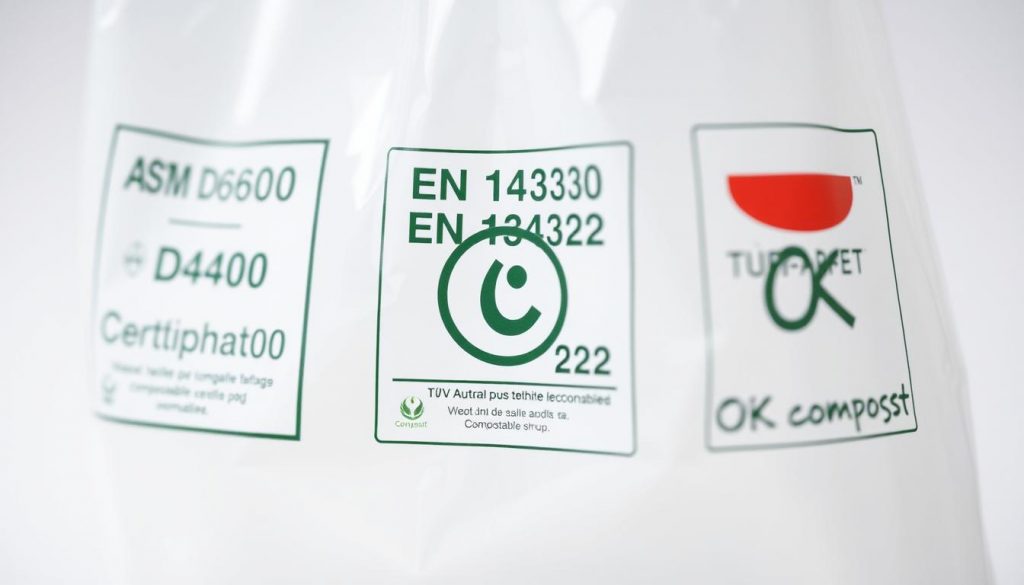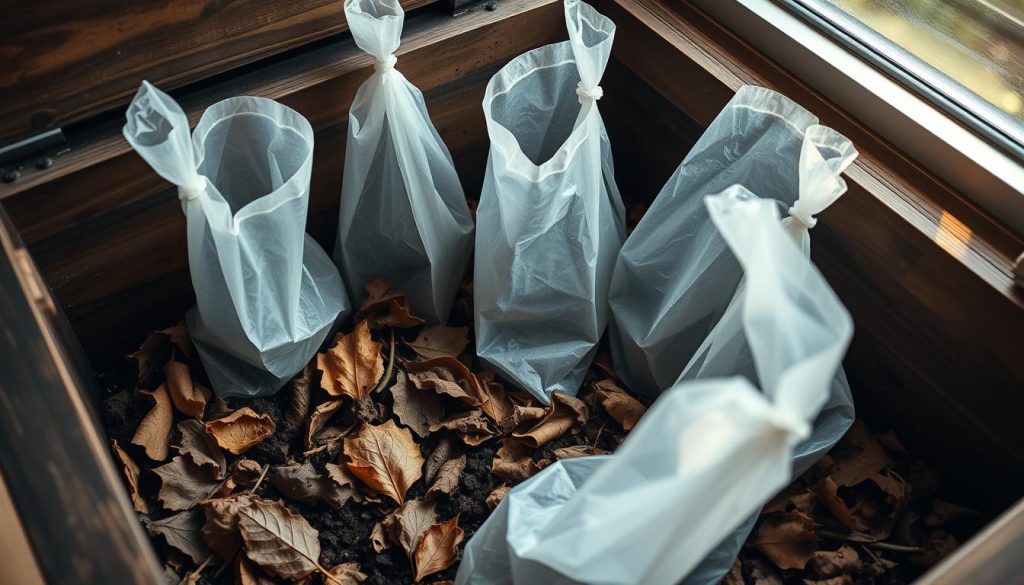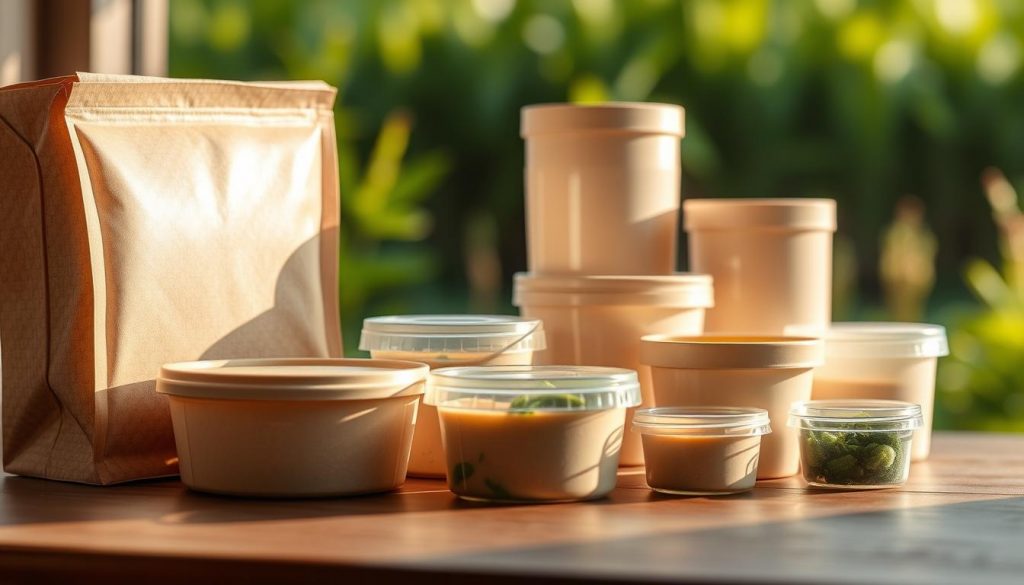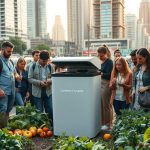I’ve been exploring eco-friendly packaging and noticed more compostable bags around. They’re seen as a green option compared to regular plastic bags.
But, the big question is: Compostable Bags: Are They Really Compostable?
A study by Sourceful found that only 3% of compostable packaging in the U.K. actually gets composted.
This fact makes us wonder if these bags are as good as they seem.
Dr. Tarun Anumol from Agilent Technologies points out that plastic bags are made from polyethylene.
It can take up to 1,000 years for this plastic to decompose in soil. This shows we need to check if these bags can really compost.
Key Takeaways
- The majority of compostable packaging doesn’t end up in proper composting facilities.
- Compostable bags may not be as eco-friendly as they seem.
- The decomposition rate of plastic bags is alarmingly slow.
- Proper composting facilities are crucial for compostable bags to break down.
- The environmental impact of compostable bags is still a concern.
The Rise of Compostable Bags in Our Eco-Conscious World
Compostable bags are becoming more popular as we try to cut down on plastic waste.
More people are looking for eco-friendly options, leading to a big increase in demand.
My First Encounter with Compostable Alternatives
I first saw compostable bags at a health food store. They were used for grocery packaging, and I was impressed.
But I wondered if they really could be composted.
The Growing Market for “Green” Packaging Solutions
The market for eco-friendly packaging is growing fast. Companies are making all sorts of compostable items, like bags and cutlery.
Eco-friendly bags are leading this trend, with many saying they’re a better choice than plastic bags.
Why I Started Questioning the Claims
As I learned more about compostable bags, I started to doubt the claims. Were these bags really compostable, or was it just a marketing trick?
I looked into the standards and certifications for compostable products.
The Environmental Protection Agency (EPA) says the U.S. isn’t ready to handle all the compostable waste. This makes us question if compostable bags really help reduce plastic waste.
“The composting infrastructure in the U.S. is not yet equipped to handle the growing volume of compostable waste.”
| Year | Compostable Bags Sold (Millions) | Growth Rate (%) |
|---|---|---|
| 2020 | 100 | 20 |
| 2021 | 120 | 15 |
| 2022 | 150 | 25 |
This push towards green living is great, but we need to look at the facts. As consumers, we should choose products wisely, thinking about their environmental impact.
Understanding What “Compostable” Actually Means
I started by asking: what makes a bag truly compostable? I found out that “compostable” bags follow strict standards and rules.
To be called ‘compostable,’ a bag must meet certain rules. For example, in the UK and EU, 90% of the bag must break down in 3 months.
It should fully biodegrade in 6 months. This is key for compostable bags certification.
Industrial vs. Home Composting Standards
Industrial and home composting are very different. Industrial facilities have controlled heat and moisture, speeding up breakdown.
Home composting, however, is less controlled and can be less effective.

The Science Behind Decomposition
Decomposition is when tiny organisms break down organic stuff into simpler forms. For compostable packaging, this means turning into carbon dioxide, water, and biomass.
How well this happens depends on temperature, moisture, and oxygen.
Time Frames for Complete Breakdown
The time it takes for compostable bags to break down changes with the composting conditions. Here’s a table showing typical times for different conditions:
| Composting Conditions | Time Frame for Breakdown |
|---|---|
| Industrial Composting | 3-6 months |
| Home Composting | 6-12 months or more |
Knowing these details helps us see the value and limits of sustainable packaging like compostable bags.
Are Compostable Bags Really Compostable? The Science Says…
More people are choosing compostable bags over plastic. But, it’s important to check if they really compost.
The bags can only compost under certain conditions that might not happen in everyday life.
Laboratory Testing vs. Real-World Conditions
Compostable bags are tested in labs, which are different from real life. Labs have perfect conditions for breaking down, like the right temperature and moisture.
But, these perfect conditions don’t always happen in our homes or even big composting places.
Temperature and Moisture Requirements
For compostable bags to break down, they need the right temperature and moisture. Dr. Tarun Anumol’s research shows they can take 10 to 60 days to decompose in soil.
But, it’s hard to get these conditions right, especially at home.
What Research Studies Have Found
Many studies have looked into how well compostable bags compost. These studies give us important information.
University Studies on Decomposition Rates
University research has shown different rates of decomposition for compostable bags. Some bags break down fast in big composting places.
For example, a study might show a bag can decompose in a few weeks in a hot composting facility.
Independent Testing Results
Independent tests have also been done on these bags. Results are mixed, with some bags working well and others not. For example, Sarah Paiji Yoo, CEO of Blueland, says bags need to be composted in big facilities to really break down.
This shows how important it is to dispose of them correctly.
In summary, compostable bags can help the environment, but they need the right conditions to work.
Knowing these conditions is key for those wanting to choose eco-friendly options.
- Compostable bags need specific conditions to decompose.
- Laboratory tests may not reflect real-world composting conditions.
- Industrial composting facilities are often necessary for effective decomposition.
Certifications and Standards: What to Look For
When you’re looking for compostable bags, knowing about certifications is key. These standards check if the bags are really eco-friendly.
Being informed helps you choose better.
ASTM D6400 and BPI Certification
In the U.S., compostable items often have the ASTM D6400 label. This shows they meet a high standard for compostable plastics.
The Biodegradable Products Institute (BPI) checks if products can be composted in big facilities.
The BPI seal is important. It means the product can be composted in big facilities.
European Standard EN 13432
In Europe, the EN 13432 standard is key. It makes sure materials can break down and don’t harm composting.
Products that pass get a ‘seedling’ logo, showing they’re compostable in big facilities.
What These Certifications Actually Guarantee
These labels mean the product can break down in big composting places. But, not all home composting can do this.
It’s important to know the difference.
Reading Between the Lines of Packaging Claims
Look for labels like “OK compost HOME” by TÜV AUSTRIA. They mean the product can be composted at home.
Always check for these labels and understand what they mean.

My Personal Testing Experience
I decided to test compostable bags in my home to see how they break down. I wanted to know if they really help reduce waste.
As someone who loves the environment, I was excited to find out.
Home Composting Experiment Setup
I set up a composting bin in my home. I put food scraps, yard waste, and compostable bags inside. The bags were certified by ASTM D6400, a standard for compostable plastics.
I used a compostable bag in my kitchen caddy for food scraps. Then, I put the bag into the outdoor bin.
This let me see how the bags work in real life.

Surprising Results After 6 Months
After six months, I was surprised. The bags didn’t fully break down. They had split into smaller pieces, but some parts were still there.
An expert said,
“Compostable bags can be a valuable tool in reducing waste, but their effectiveness depends on various factors, including the composting conditions and the type of material used.”
This showed me the limits of compostable products.
Lessons Learned from My Backyard Science
My experiment taught me a lot about composting eco-friendly bags.
It showed that how well these bags break down depends on the composting environment.
What Worked and What Didn’t
The parts of the bags touching the food scraps broke down better.
This taught me the importance of mixing and aeration in composting.
Variables That Affected Decomposition
Many things affected how fast the bags decomposed. Temperature, moisture, and the carbon-to-nitrogen ratio in the compost pile were key.
Keeping these conditions right was essential for good decomposition.
In conclusion, testing compostable bags in my home gave me important insights.
They are a good eco-friendly option, but their success depends on several factors.
The Environmental Impact Beyond Composting
Using compostable bags is a step towards a greener future. But, we must look at their whole life cycle effect on the planet.
They are better than regular plastics, but making and throwing them away still hurts the environment.
Resource Consumption in Manufacturing
Making compostable bags uses a lot of water and energy. For example, bags made from cornstarch need a lot of corn.
One study showed that making one ton of PLA, a common bag material, takes 1,100 kWh of electricity and 1.4 tons of corn.
Carbon Footprint Comparison
Comparing compostable bags to regular plastics shows mixed results. Some say compostable bags are better for the planet.
But, others say the difference is small when looking at everything from start to finish. It’s important to do a full lifecycle assessment to really see the carbon impact.

Land Use and Agricultural Implications
Using natural materials for packaging means we need more land. For example, growing corn for bags. With climate change, land is more precious than ever.
It’s needed for food, forests, and to capture carbon.
- Increased demand for agricultural land
- Potential diversion of land from food production
- Impact on biodiversity due to monoculture farming practices
My Perspective on the Full Lifecycle Assessment
I believe a full lifecycle assessment is key to understanding compostable bags. We need to look at every step, from getting the raw materials to how they end up.
This way, we can make better choices for a greener future.
The American Reality: Infrastructure and Consumer Behavior
My journey into compostable bags revealed a surprising fact: the US doesn’t have enough places to process them.
As more people use compostable bags, it’s key to look at how America handles waste.
The State of Commercial Composting Facilities in the US
The US has only a few places where big composting facilities can handle compostable packaging. The United States Environmental Protection Agency (EPA) says there are over 4,700 composting spots in the country.
But not all of them can take in compostable packaging.
| Type of Composting Facility | Number of Facilities | Accept Compostable Packaging |
|---|---|---|
| Large-scale composting facilities | 250 | Yes |
| Small-scale composting facilities | 4,000+ | Limited or No |
| Backyard composting | N/A | No |
How American Waste Management Systems Handle Compostables
American waste systems aren’t set up to deal with compostable packaging well. Many places that can compost these bags don’t exist.
So, these bags often end up in landfills or incinerators.
The Disconnect Between Product Claims and Disposal Options
There’s a big gap between what compostable bag makers say and where you can throw them away. Many people think their bags are being composted, but they’re not.
To fix this, we need better places for composting and to teach people how to throw away these bags right.
This way, we can lessen the harm these products cause and make sure they do what they’re meant to do.
Common Misconceptions About Compostable Bags
The talk about compostable bags is often mixed up. It’s time to clear up the confusion.
I’ve looked into eco-friendly packaging and found many wrong ideas about these bags.
The Biodegradable vs. Compostable Confusion
Many get confused between “biodegradable” and “compostable.” ‘Biodegradable’ means anything that breaks down over time, but it doesn’t mean it’s good for the environment. On the other hand, “compostable” means it turns into nutrient-rich compost.
Not all biodegradable bags are compostable, as a review shows.
The “It’s Natural So It’s Better” Fallacy
Some think compostable bags are better just because they’re made from natural stuff like cornstarch or sugarcane.
But, how they’re made and thrown away is key to their environmental effect. Being natural isn’t enough; they must fit into our waste systems well.
The Reality of Disposal Infrastructure
Many think compostable bags can be easily composted at home or in local places. But, many areas don’t have the right setup for this.
This gap between bag design and disposal can cause bad environmental effects.
Myths I Once Believed Myself
I used to think compostable bags were a simple fix for plastic waste. But, through my research, I’ve learned that
“the devil is in the details.”
It’s important to understand the details of compostable bags to make smart choices. Are compostable bags really compostable?
The answer depends on how they’re made, certified, and thrown away.
The Economics of Going Green: Are Compostable Bags Worth the Cost?
Eco-conscious consumers often wonder if compostable bags are worth the extra cost. I looked into the economics of compostable bags and found it’s not simple.
It’s about comparing their cost to regular bags, understanding hidden costs and benefits, and seeing if they’re good for the average household.
Price Comparison with Conventional Alternatives
Compostable bags cost more than regular ones. But, as more people want them, prices are getting closer.
For example, a reusable plastic bag needs to be used 4-20 times to beat a disposable one. A cotton tote bag also needs to be used many times to be eco-friendly.
Hidden Costs and Benefits
There’s more to think about than just the upfront cost. Compostable bags can save money on waste disposal and help the environment.
But, they need special conditions to break down, which not all waste systems provide.
My Cost-Benefit Analysis for the Average Household
For most households, choosing compostable bags depends on several things. It’s about their current waste habits and budget.
Compostable bags are good for the planet, but they’re pricier and need the right disposal setup.
By considering these points, families can decide what’s best for their budget and the environment.
Conclusion: Making Informed Choices About Compostable Products
Reflecting on my journey with compostable bags, I see how key it is to make smart choices about green living.
The debate on compostable bags being truly compostable is complex. It involves certifications, the availability of composting services, and how we behave as consumers.
When composting services are around, using compostable products can greatly lessen our environmental impact.
This is especially true for biodegradable bags that meet strict standards like ASTM D6400.
To make a difference, we need to grasp the details of compostable products and the need for proper disposal.
By picking products with certified compostable packaging and backing local composting efforts, we help create a greener future.
My research has revealed that compostable bags are not a complete solution. Yet, they can be a helpful step in reducing waste if used wisely.
As we aim for a more eco-friendly life, making informed choices about sustainable packaging is vital.







